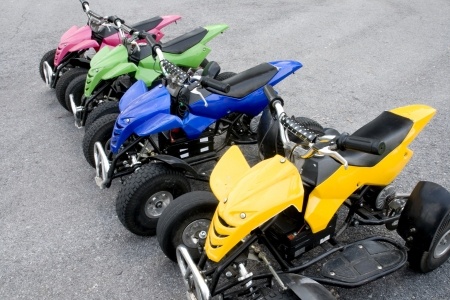ATVs - A Safety Wake-Up Call?
September 5, 2014 | Category: ATV Accidents | ShareIn June 2014 Amy Van Dyken, six-time Olympic gold medalist swimmer, severed her spine in an all-terrain vehicle (ATV) accident. The local police department said that the ATV she was driving hit a restaurant parking lot curb and sent her over a drop-off of between five to seven feet. Two months later, Amy is working seven hours a day with the same determination she had in preparing for the Olympics and her six gold medals, according to an interview with the Today show on Friday, August 22.
"Amy's accident should be a wake-up-call that ATVs can be dangerous," reminded Attorney Randall Spivey of Spivey Law Firm, Personal Injury Attorneys, P.A.
 According to the Florida Department of Highway Safety and Motor Vehicles at least 25 children ages 15 and under were involved in ATV accidents in North Central Florida between January 2012 and September 2013. This is an average of one every week. The U.S. Consumer Product Safety Commission reported that Florida has ranked in the top ten states for ATV-related deaths from 1982 to 2007 (most recent statistics).
According to the Florida Department of Highway Safety and Motor Vehicles at least 25 children ages 15 and under were involved in ATV accidents in North Central Florida between January 2012 and September 2013. This is an average of one every week. The U.S. Consumer Product Safety Commission reported that Florida has ranked in the top ten states for ATV-related deaths from 1982 to 2007 (most recent statistics).
Why are ATVs dangerous?
The Mayo Clinic report, ATVs Too Much For Kids To Handle, says that children are more likely to require hospitalization or die when involved with ATV accidents than in bicycle accidents. About one third of ATV-related emergency room visits, and one quarter of the deaths nationwide are children.
The Mayo Clinic's injury prevention coordinator, Todd Emanuel, R.N. says, "An ATV is basically a chassis with four wheels and a high center of gravity, so it's inherently unstable. And the driver's body movement is an integral part of the handling."
They further report that roll-overs are the most common cause of ATV-related injuries. This is not only because of the instability but also because of where and how ATVs are driven. Mr. Emanuel says that the wheels of ATVs do not turn or contact the pavement as car wheels do so they are more likely to flip over.
Dr. Ballinger of the Mayo Clinic notes, "An ATV is essentially an engine with four wheels. These vehicles can go 80 miles an hour on a flat surface, but there is no harness, seat belt or cab for protection."
The most common ATV injuries seen at the Mayo Clinic between 2010 and 2011 were head injuries.
How to prevent ATV accidents? ATVSafety.org. in "Tips and Practice Guide for the All-Terrain Vehicle Rider" says the following:
1. Know your ATV.
ATVs are intended for off-road use only. Never operate an ATV on public roads, and always avoid paved surfaces. ATVs are not designed for use on public roads and other motorists may not see you. ATVs are not designed to be used on paved surfaces because pavement may seriously affect handling and control.
ATVs are also different from other vehicles. They handle differently and the handling characteristics vary among ATVs depending on this basic design and how they are equipped.
- Most ATVs have separate front and rear brake controls, while some may have linked brakes operated by a single control. ATVSafety.org recommends being sure to learn the recommended stopping techniques for your machine.
- There are ATVs with electric starters, kick-starters, and pull starters.
- There are liquid-cooled ATVs and air-cooled ATVs.
- Some ATV transmissions have automatic clutches; some have hand-operated clutches; some are foot-shifted, some are hand-shifted; some transmissions are fully automatic.
- Some ATVs have a reverse gear.
- Most ATVs have solid drive axles and some have differentials.
- Some ATVs have two-wheel drive, and some have four-wheel drive.
- Some ATVs have chain drives, others have shaft or belt drives.
- Most throttles are controlled by pushing a thumb lever next to the handgrip; others may be controlled by twisting a handgrip.
- Controls and their locations differ from one ATV model to another.
- Some ATVs are for single rider only and some ATVs can carry a passenger.
2. Wear protective equipment such as helmets and eye protection.
3. Do a pre-ride inspection of:
- Controls
- Lights and switches
- Oil and fuel
- Chain/driveshaft and chassis and
- Have a tool kit.
4. Inspect the driving area to be sure it is flat and has no obstructions.
5. Review the starting procedure in the owner's manual.
6. Have the correct posture:
- Head and eyes up, looking well ahead.
- Shoulders relaxed, elbows bent slightly out, away from your body.
- Hands on the handlebars.
- Knees in toward the gas tank.
- Feet on the footrests with toes pointing straight ahead.
"These are just some of the tips from the ATV Safety Organization. We recommend that before riding an ATV, riders review the complete ATV Safety Organization guide. Here is a link for your convenience: ATV Riding Guide," says Attorney Randall Spivey of Spivey Law Firm, Personal Injury Attorneys, P.A.
Fort Myers ATV Accident Attorney , Randall L. Spivey is a Board Certified Trial Attorney – the highest recognition for competence bestowed by the Florida Bar and a distinction earned by just one (1%) percent of Florida attorneys. He has handled over 2,000 personal injury and wrongful death cases throughout Florida. For a free and confidential consultation to discuss your legal rights, contact the Spivey Law Firm, Personal Injury Attorneys, P.A., in Lee County at 239.337.7483 or toll free at 1.888.477.4839,or by email to Randall@SpiveyLaw.com. Visit SpiveyLaw.com for more information. You can contact Spivey Law Firm, Personal Injury Attorneys, P.A.in Charlotte County at 941.764.7748 and in Collier County 239.793.7748.

